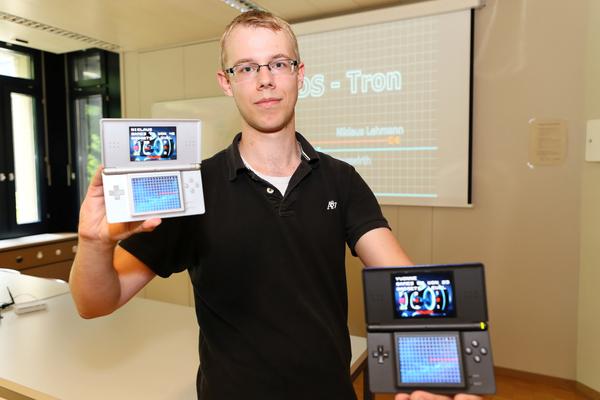A pocket synthesizer that also rides a motorcycle

Luis Gaemperlé is among the winners of the 2012 "Nintendo DS constest". © 2012 EPFL
SUMMER SERIES - Student projects (2). For the second edition of the Nintendo DS programming contest, bachelor students from the Embedded Systems course were set in nine teams made of two members each that competed against one another. The jury could not decide between the best two.
Students have given free rein to their imagination. David Atienza, director of the Embedded Systems Laboratory, experimented this year, for the second time, a method of empirical teaching that finds immediate success among his young students. During the semester that just ended, the sixth of their course, they received a portable Nintendo DS console on loan. The goal: to create, in teams of two students, a program that makes the most of the console’s various features, for instance: by developing a game from A to Z.
Last week, nine groups of students presented the fruits of their work before a panel of experts. From "Minesweeper" to a shooting game and from a naval battle to a puzzle whose solution allows freeing a prisoner, the students showed great imagination and expertise in the creation of their software.
Given the quality of this year’s results, the jury could not decide between the two best projects. With "OSC Based Multi-Channel Step Sequencer", Michael Tschannen and Luis Gaemperlé created a program that composes electronic music on the handheld console and then plays it via Wi-Fi on "real" instruments connected to a MIDI box (see their persentation video below).
Adrian Hauswirth and Niklaus Lehmann were for their part inspired by "Tron," an arcade game from the early 80s, in order to make a DS version of it. The game consists on riding a motorcycle, seen from above, by avoiding obstacles and collecting bonuses. "The strength of these students was to exploit the Wi-Fi possibilities of the console so that 6 people could play simultaneously," said David Atienza. In multiplayer mode, participants must also be able to avoid collisions among themselves...

Michael Hauswirth developed a "DS" version of the famous "Tron" arcade game. © Alain Herzog / EPFL
For their teacher, this second edition’s success reflects the relevance of this teaching approach. "These consoles are "complex" machines in the sense that they contain several input devices, two screens and a Wi-Fi connection. However, they have little memory and rather weak processors, which compels students to develop software that is able to run in a resource constrained hardware environment. "
Given the quality of this year’s students performance, David Atienza is already anticipating next school year’s course: fifth semester students will work with the Japanese console, "and we shall move up a gear in the sixth semester, he explains. The challenge will consist on programming software for smartphones, which are much more complex and powerful." Bets are on for some spectacular work!